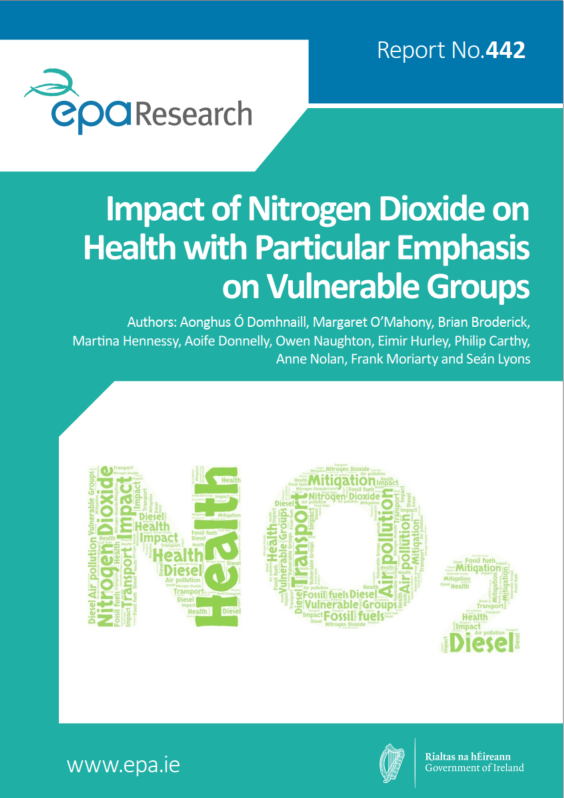Research 442: Impact of Nitrogen Dioxide on Health with Particular Emphasis on Vulnerable Groups
Authors: Aonghus Ó Domhnaill, Margaret O’Mahony, Brian Broderick, Martina Hennessy, Aoife Donnelly, Owen Naughton, Eimir Hurley, Philip Carthy, Anne Nolan, Frank Moriarty and Seán Lyons
Summary: Exposure to nitrogen dioxide (NO2) is associated with adverse effects on hospital admissions for various diagnoses; respiratory illnesses such as asthma, cancer, adverse birth outcomes, as well as mortality. The main source of NO2 in Ireland is road transport, particularly diesel engines. Other sources include off-road machinery, industrial and construction activities, and electricity and heat production. This research project analysed associations between the model estimations of NO2 and the health data of 8000 adults aged over 50 years. Using the HSE-PRCR prescribing database, the project found a positive association between respiratory item prescription rates and PM2.5 levels, while the results for NO2 were inconclusive. The project also developed an enhanced Wind Sector Land Use Regression (WS-LUR) model that estimates ambient NO2 concentrations at any location in Ireland with particular emphasis on vehicle fleet changes and traffic flow impacts on NO2.

Identifying pressures
Exposure to nitrogen dioxide (NO2) is associated with adverse effects on hospital admissions for various diagnoses; respiratory illnesses such as asthma, cancer, adverse birth outcomes, as well as mortality. The main source of NO2 in Ireland is from road transport, particularly diesel engines. Other sources include off-road machinery, industrial and construction activities, and electricity and heat production.
The project involved a number of analyses. In the first, associations between the model estimations of NO2 and the health data of >8000 adults aged over 50 years (TILDA database) indicated that a 1ppb increase in NO2 concentration was associated with a 0.24 percentage point increase in the probability of reporting an asthma diagnosis. In another analysis, using the HSE-PRCR prescribing database, the project found a positive association between respiratory item prescription rates and PM2.5 levels but the results for NO2 were inconclusive. The project also developed an enhanced Wind Sector Land Use Regression (WS-LUR) model that can estimate ambient NO2 concentrations at any location in Ireland with particular emphasis on vehicle fleet changes and traffic flow impacts on NO2. The model was used to assess mitigation policies for the reduction of NO2.
Informing policy
The results of the respiratory item prescribing rate analysis using the HSE-PCRS database demonstrated a strong positive association between PM2.5 and prescribing rates, particularly in young children. The results of the analysis of NO2 levels on the health of older adults demonstrated a strong positive association with asthma prevalence. Policies seeking to improve air quality nationally, therefore, need to be intensified.
The mitigation strategy analyses showed how a range of possible traffic management and infrastructure measures could reduce overall NO2 levels. Therefore, it is recommended that resources and policy development are targeted at developing incentives to reduce car use, promoting and adequately resourcing public transport and active transport modes.
Initial investigations as part of the project concluded that researcher access to available health datasets is extremely limited, reducing the potential to study the impacts of air pollution on health. It is recommended that policies and protocols be developed to enable researchers to access existing health data, without compromising privacy.
Developing solutions
As transport is the largest source of NO2 in Ireland, a key focus of the project was to develop solutions for this sector. The analysis of the impact of Covid-19 demonstrated that significant reductions in some air pollutants were realised when a large proportion of the population worked from home. Homeworking has the potential to contribute significantly to improving air quality relating to NO2.
A range of potential solutions were evaluated in the mitigation strategy analyses. They included relocating businesses away from highly polluted areas, replacing diesel with electric vehicles in the public service fleets, introducing a Low Emission Zone in Dublin and introducing a bypass/ring road around a city. All strategies lowered traffic levels in different contexts and thereby reduced modelled NO2 levels. While some strategies may be more easily implemented than others, all offer significant potential to reduce air pollution.
https://www.epa.ie/media/epa-2020/publications/research/Cover-Image-442.png